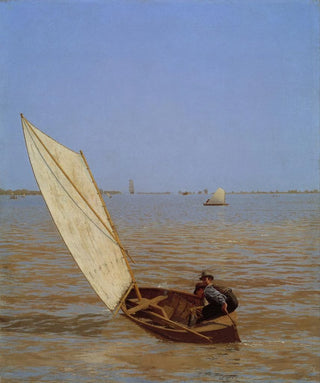Art print | Starting after the rail - Thomas Eakins


View from behind

Frame (optional)
"Start after the rail" by Thomas Eakins is an iconic artwork that transcends the simple frame of painting to engage in a broader reflection on the human condition and the interaction between the individual and their environment. This canvas, depicting a moment of transition and movement, invites the viewer to contemplate the idea of departure and arrival, of life flowing by and the choices that shape our existence. Eakins, master of realistic representation, manages to capture not only the physicality of the characters but also the emotional intensity emanating from this scene, immersing us in a universe where every detail matters.
Style and uniqueness of the work
Thomas Eakins's style is characterized by a meticulous approach to realism, where each element is treated with almost scientific precision. In "Start after the rail," the human figures are rendered with such authenticity that they seem almost alive, ready to step out of the painting. The carefully orchestrated light plays a crucial role in the composition, highlighting the expressions of the protagonists and creating an atmosphere that is both dynamic and contemplative. Eakins does not hesitate to explore complex themes such as movement, time, and engagement, which gives his work a rare depth. The color palette, both rich and nuanced, enhances the visual impact of the scene, making this painting a true masterpiece that intrigues and fascinates.
The artist and his influence
Thomas Eakins, born in 1844 in Philadelphia, is often regarded as one of the greatest American artists of his time. His artistic training, marked by studies in Europe, allowed him to incorporate classical techniques while developing a sensitivity unique to his cultural context. Eakins established himself as an innovator, challenging the artistic conventions of his era. His commitment to realism and his interest in representing the human body profoundly influenced his contemporaries and future generations. By exploring often neglected subjects, such as daily life and human activities, he paved the way for a new appreciation of art as a reflection of society. His legacy endures.

Matte finish

View from behind

Frame (optional)
"Start after the rail" by Thomas Eakins is an iconic artwork that transcends the simple frame of painting to engage in a broader reflection on the human condition and the interaction between the individual and their environment. This canvas, depicting a moment of transition and movement, invites the viewer to contemplate the idea of departure and arrival, of life flowing by and the choices that shape our existence. Eakins, master of realistic representation, manages to capture not only the physicality of the characters but also the emotional intensity emanating from this scene, immersing us in a universe where every detail matters.
Style and uniqueness of the work
Thomas Eakins's style is characterized by a meticulous approach to realism, where each element is treated with almost scientific precision. In "Start after the rail," the human figures are rendered with such authenticity that they seem almost alive, ready to step out of the painting. The carefully orchestrated light plays a crucial role in the composition, highlighting the expressions of the protagonists and creating an atmosphere that is both dynamic and contemplative. Eakins does not hesitate to explore complex themes such as movement, time, and engagement, which gives his work a rare depth. The color palette, both rich and nuanced, enhances the visual impact of the scene, making this painting a true masterpiece that intrigues and fascinates.
The artist and his influence
Thomas Eakins, born in 1844 in Philadelphia, is often regarded as one of the greatest American artists of his time. His artistic training, marked by studies in Europe, allowed him to incorporate classical techniques while developing a sensitivity unique to his cultural context. Eakins established himself as an innovator, challenging the artistic conventions of his era. His commitment to realism and his interest in representing the human body profoundly influenced his contemporaries and future generations. By exploring often neglected subjects, such as daily life and human activities, he paved the way for a new appreciation of art as a reflection of society. His legacy endures.






